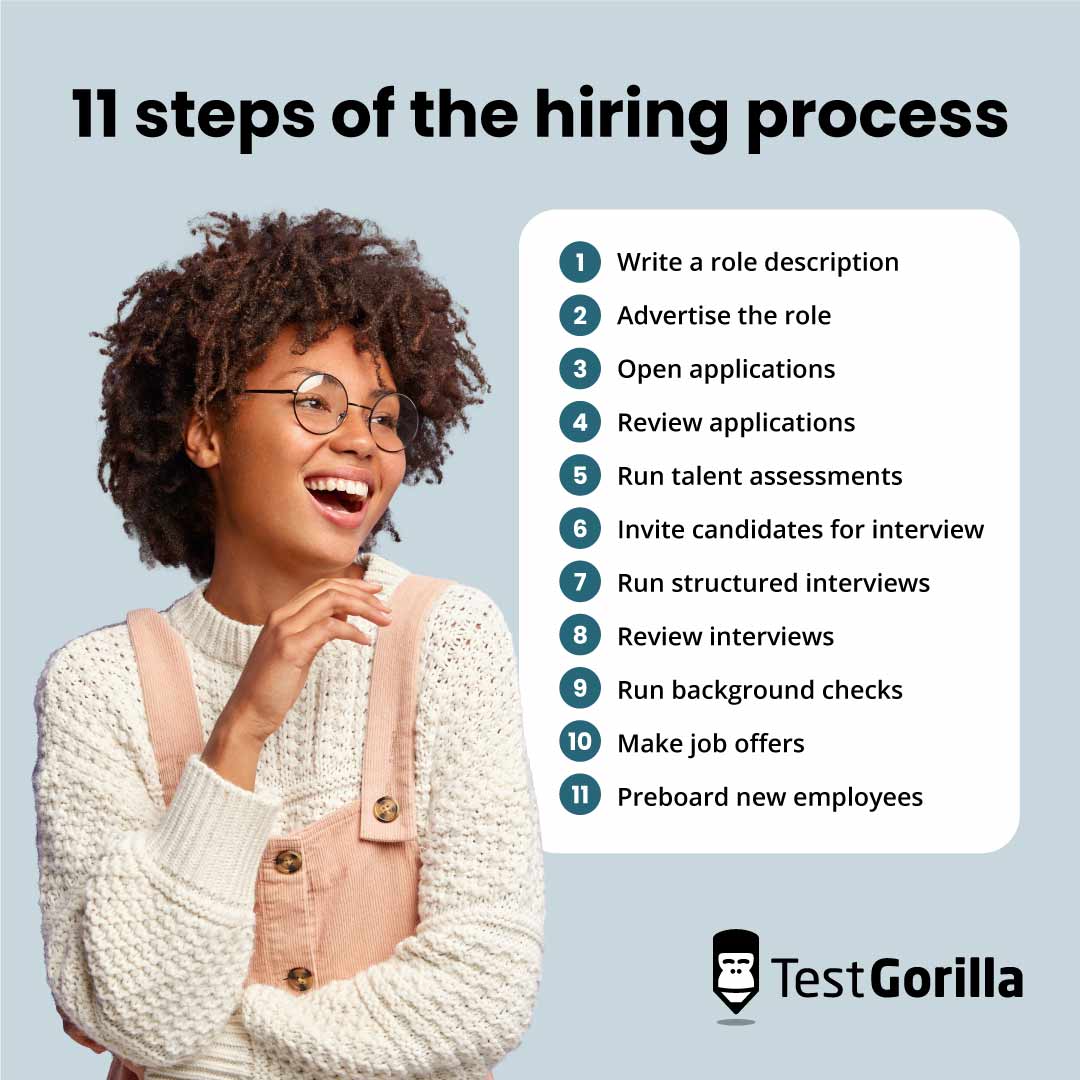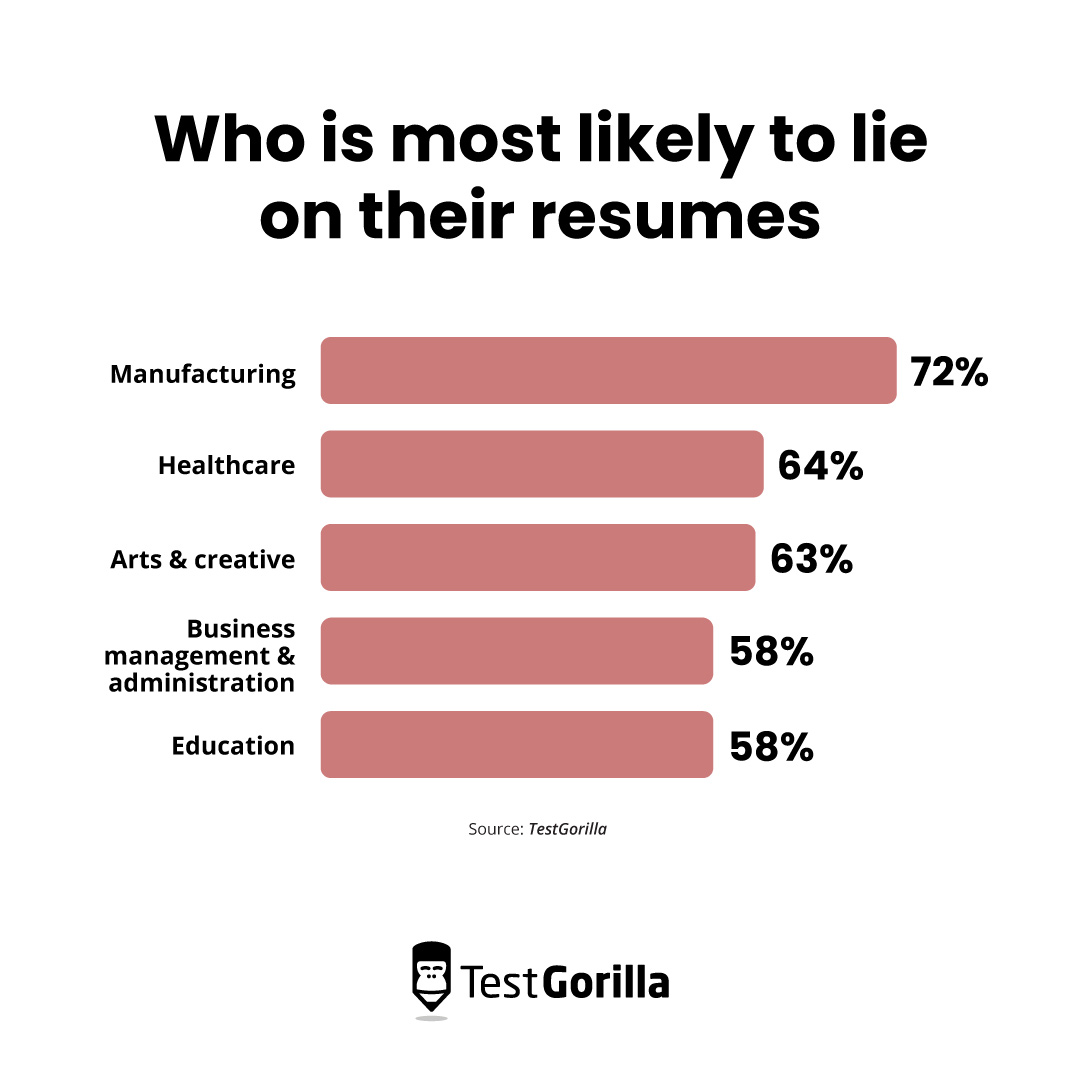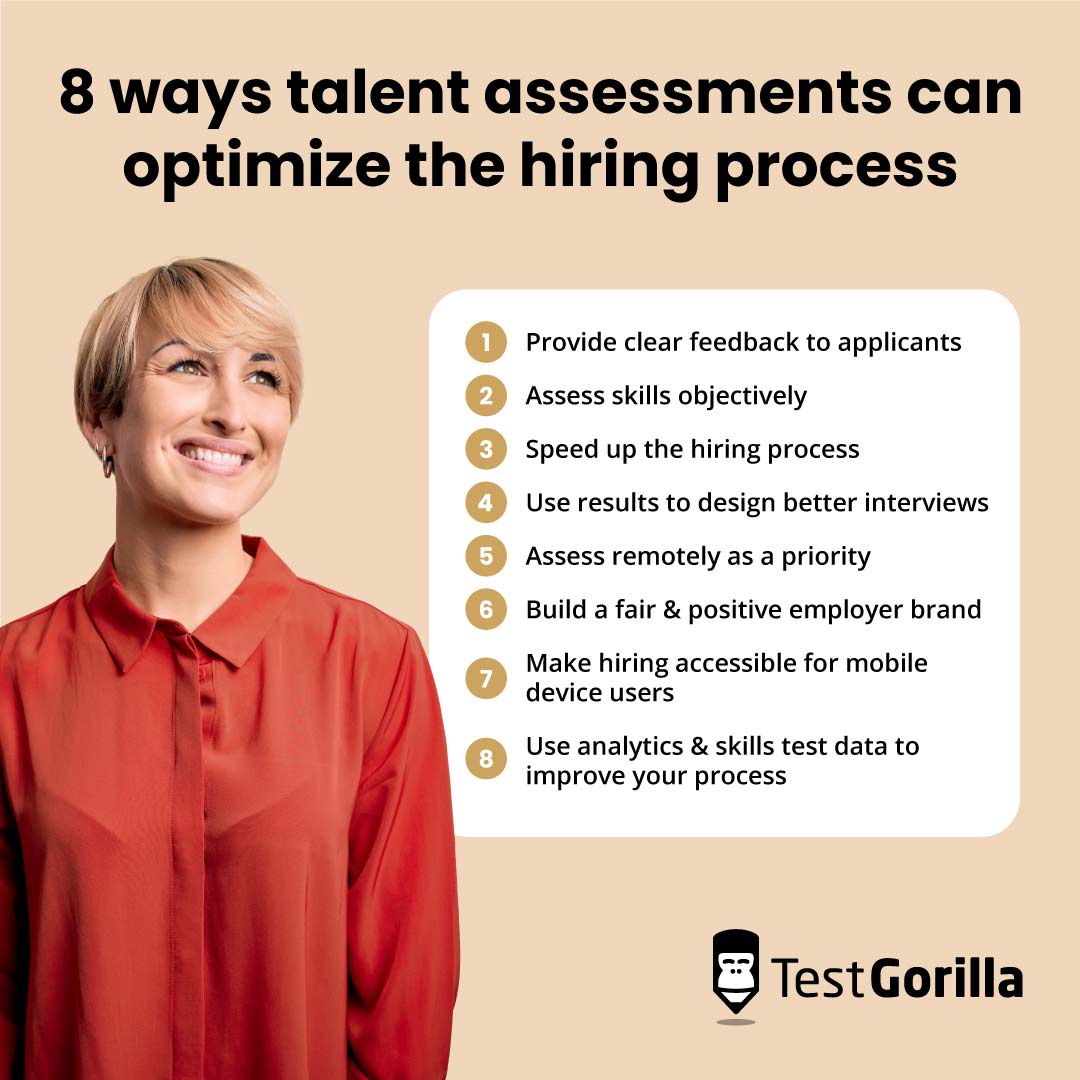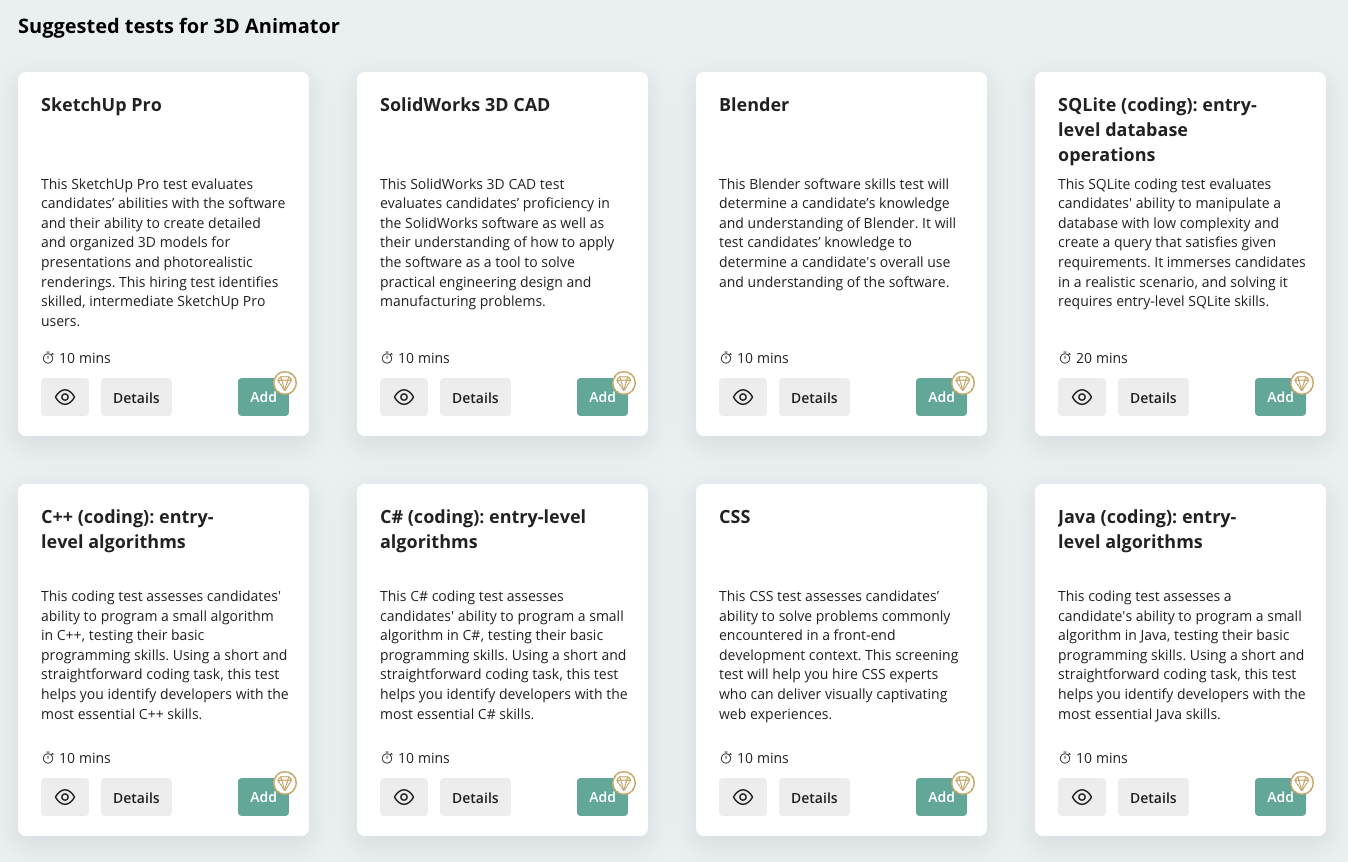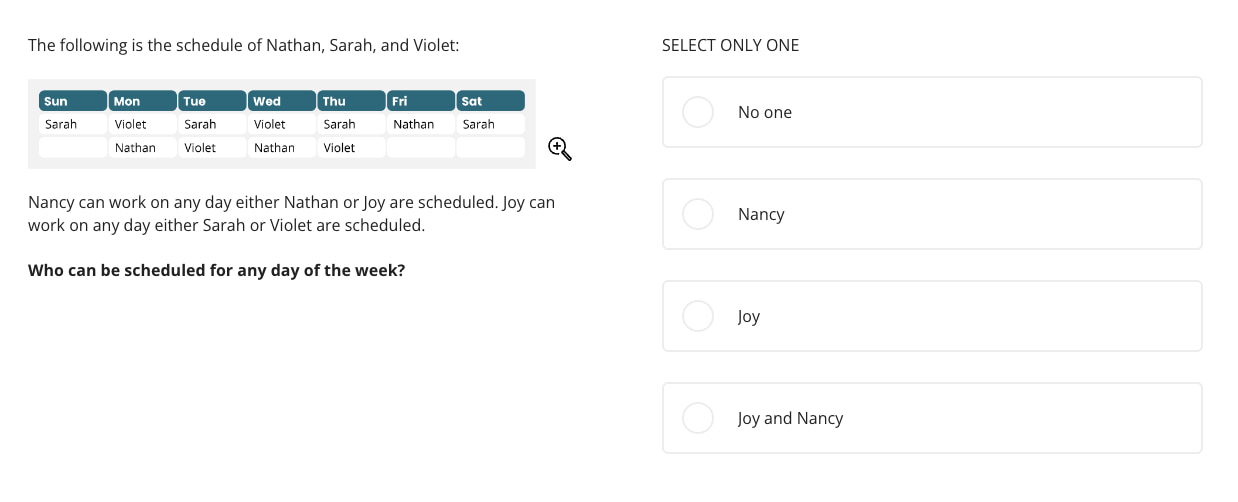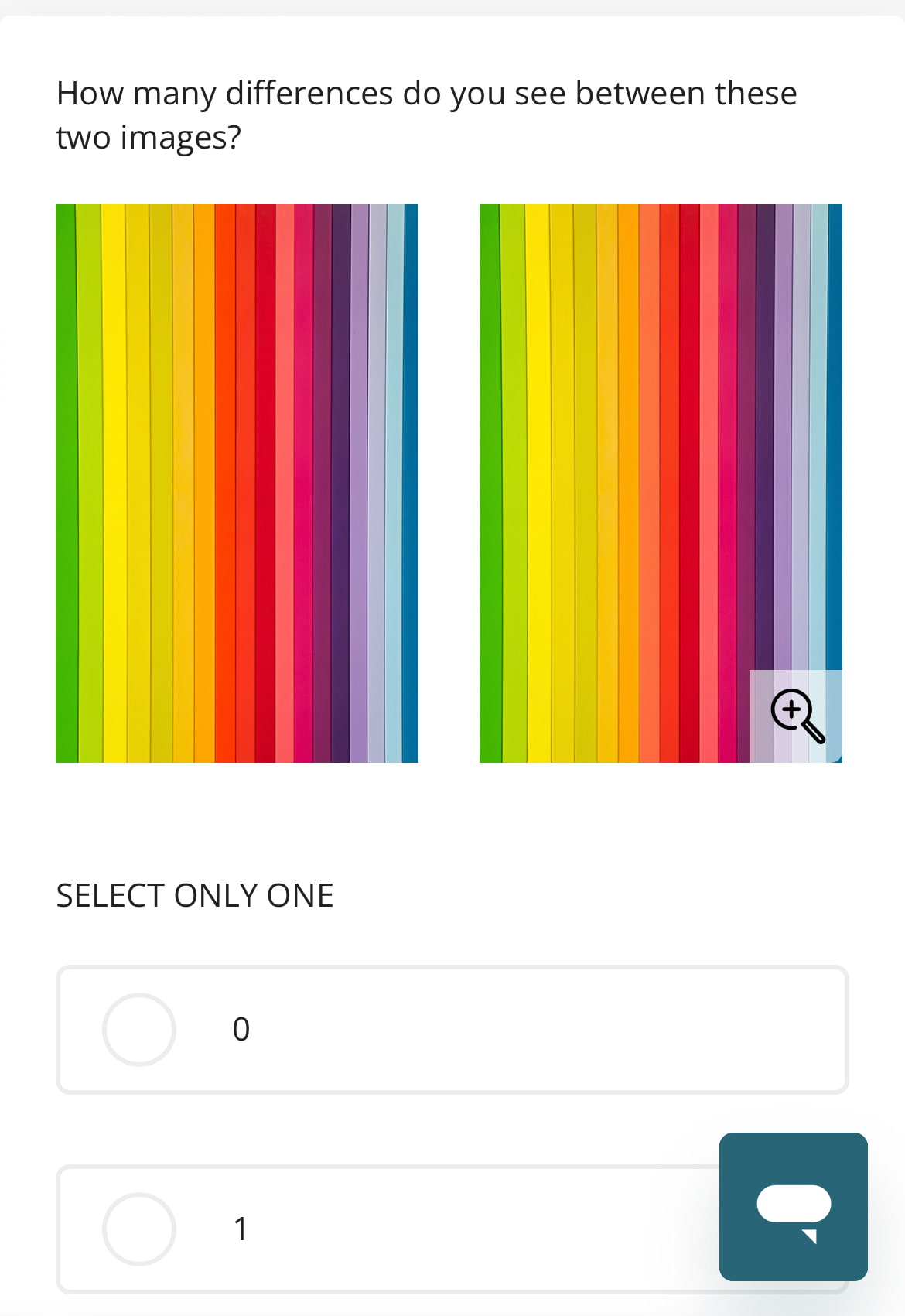Hiring process: How talent assessments help you measure candidate excellence at each stage
You’re checking resumes carefully and running two or three interviews for every role. Yet, you’re still hiring unreliable people who you end up letting go.
Far more suitable hires are quitting your process early – they're confused, frustrated, and tired of waiting around. As in-demand professionals, their time is precious.
Because of this, your hiring process needs an overhaul.
Optimizing your hiring doesn’t just mean adjusting and refining job descriptions, however. There are many different stages to consider.
At every stage, the key to making the recruitment process easier to manage lies in talent assessments. Skills tests are easy to use, easy to evaluate, and easy to implement.
By using skill tests in your process for hiring, you can:
Cut down on time-to-hire and applicant ghosting
Increase workplace diversity and broaden your talent pool
Guide highly talented and motivated employees through your process
Reduce the number of costly mis-hires
Below, we explore 11 typical hiring process steps and the difficulties associated with them before deep diving into how to use talent assessments to guide ideal candidates through recruitment.
Table of contents
- What is the hiring process?
- Hiring process steps: The 11 stages to follow
- The difficulties with the recruitment and hiring process
- How talent assessments help with hiring processes
- 8 ways to use talent assessments to optimize the hiring process
- Beyond talent assessments: 3 best practices to remember for better hiring processes
- Choose talent assessments for an efficient, effective hiring process
What is the hiring process?
The hiring process is a series of steps you take to find, assess, and recruit new employees.
It’s an important roadmap that helps recruiters ensure they hire people who add talent and productivity to their workforces.
However, the process accounts for more than simply listing a job, interviewing an applicant, and writing an offer letter.
An effective hiring process checklist helps recruiters carefully assess skills and “culture add” potential while keeping applicants engaged.
Hiring process steps: The 11 stages to follow
Recruitment looks different for every firm, but here are 11 stages an efficient and effective hiring process checklist should follow.
A basic hiring process timeline: What to include
Hiring step | Quick summary |
1. Write a role description | Composing clear, descriptive responsibilities helps suitable applicants understand what you need and deters unqualified people |
2. Advertise the role | Sharing roles across different job boards and social platforms (i.e., LinkedIn) helps you broaden your talent pool and reach as many people as possible |
3. Open applications | Declaring applications open and setting a clear closing date helps recruiters prepare for the next process stages and sets clear expectations for applicants |
4. Review applications | Checking basic application details helps you vet who can legally work for you and who has relevant skills you can test for |
5. Run talent assessments | Testing applicants for skills ensures you objectively understand their capabilities and personalities before you get to interview; you avoid gut instinct and the risk of cutting out talented people |
6. Select and invite candidates for interview | Setting expectations for applicants ensures they have plenty of time to prepare and to attend with punctuality |
7. Run structured interviews | Running job interviews with structured questions keeps the interview process fair and inclusive for all candidates while producing reliable, unbiased data for review |
8. Review interviews / pursue additional assessments | Reviewing interviews helps you confirm your impressions from applicants’ skills tests – and running additional interviews is wise if you have other available opportunities they’re suitable for |
9. Run background checks | Background checks are needed in some roles where you need to keep the public safe or if it's a legal requirement in your industry |
10. Select the candidates you wish to hire and make job offers | Reaching out to people whose test results match your role profiles and who impress you at interviews gives them the flexibility to accept or decline your offers – and a clear timeframe to make a decision comfortably |
11. Preboard new employees and schedule onboarding | Preboarding people who accept job offers helps give them confidence that you'll follow through on your promises and you can answer their questions before you arrange new employee onboarding |
The best insights on HR and recruitment, delivered to your inbox.
Biweekly updates. No spam. Unsubscribe any time.
The difficulties with the recruitment and hiring process
The average recruitment and hiring process might seem simple on paper, but recruiters sometimes struggle with:
Getting quality candidates through the process
Managing hiring bias
Keeping the selection process timeline efficient
Avoiding the costs of mis-hiring
Verifying references
Let's explore these before showing you how talent assessments help you manage such problems.
Getting quality candidates through the process
Many great candidates feel locked out of hiring processes because of the demand for specific degrees or years of experience.
Relying on resume screening and education checks bottlenecks the hiring process, meaning many high-quality or high-potential employees either don't apply at all or fail to make it to an interview.
For example, it’s estimated around 76% of people in the US aged 25 or older don't have bachelor's degrees. Making a bachelor's degree a role requirement locks out three-quarters of the population, who may still have the skills you need.
Some highly qualified candidates even miss out on roles because HR accidentally filters them out at the application stage.
For instance, a recruiter could use applicant tracking systems that prioritize or filter people based on specific keywords. If talented candidates don't use such keywords in their resumes or applications, they're filtered out.
This particular trend is a large concern for as many as 88% of business owners.
Managing hiring bias
Most hiring process steps are at high risk of unconscious bias. Intentionally or otherwise, recruiters sometimes judge candidates on their age, gender, race, and physical appearance.
Unintentional bias in hiring can stop recruiters from thinking critically because they’re distracted by personal values instead of looking closely at an applicant’s eligibility and personality traits.
In fact, most interviewers decide whether or not they like an applicant within 15 minutes of meeting them. They rely on bias and gut instinct rather than objective proof of a candidate's value.[1]
Relying on bias risks mis-hiring and avoids the perks of diversity hiring, which means you further risk narrowing your talent pool.
Skills testing provides complete objectivity, meaning you focus purely on talent, regardless of a candidate's background or profile.
Keeping the selection process timeline efficient
Research shows US firms are taking longer than ever to hire people, with the average hiring process now taking up to 44 days from job posting to onboarding.
These hiring processes slow down when recruiters take excess time to check and measure candidates.
As an example, they could pass applications between multiple hiring team members, run several in-person interviews, and demand lengthy assessments.
Hiring efficiency makes or breaks recruitment quality. For instance, some top talent could receive faster offers from competing firms and leave you with less suitable candidates.
Long hiring processes sometimes leave roles unfilled, reducing in-house productivity and stunting competitiveness.
Moreover, you risk harming your public reputation and employer branding, meaning fewer talented people apply with you.
Avoiding the cost of mis-hiring
Mis-hiring occurs when an employee joins a company, but it turns out they add little to the role and might even be detrimental to the team.
This scenario can occur when recruiters rely on subjective bias and experience checks alone.
Although measuring education and work experience is nothing new in the hiring process, the advent of skills testing is helping recruiters realize they need to run additional checks to judge talent and role suitability.
Some recruiters mis-hire when relying solely on resume fluff and not considering an applicant's personality or “culture add” – as opposed to “culture fit,” which discourages diversity and creative thinking.
These recruiters risk hiring an asshole genius, someone with an impressive resume but who raises negativity and drives down creativity.
Unfortunately, people do lie on their resumes, and it's not exclusive to one or two industries:
Workforce problems aside, mis-hiring is financially costly – companies waste around $17,000 on every bad hire.[2]
In addition, mis-hiring leads to lowered team morale, reduced productivity, and increased turnover.
Verifying references
References are outdated measures for judging applicants on job suitability. Studies suggest they only provide helpful insights 13% of the time.[3]
Work and education references are hard to verify because they're subject to bias. Moreover, suitable candidates might not have references if they leave their roles due to poor management or toxic environments.
Think about it – if you were excellent at your last job, but your boss was terrible and abusive, would you want to use them as a reference when you look for work elsewhere?
Again, people sometimes lie on their resumes. Reportedly, one in six people use reference faking services with actors and false claims.[4]
Therefore, you can’t reliably judge someone’s suitability on reference checks alone, if at all.
How talent assessments help with hiring processes
The answer to avoiding the traps of bias and mis-hiring is to use objective, irrefutable data instead. That’s where talent assessments come in handy.
By skills testing your candidates, you’re free to build a more fair, balanced, and holistic hiring process instead.
Use assessments in your hiring process to:
Reduce candidate ghosting
Improve recruitment diversity
Boost assessment confidence
Reduce time-to-hire
Let’s explore how.
1. Reduce candidate ghosting
Candidate ghosting occurs when someone leaves the hiring process mid-application.
It’s likely happened to you before – surveys show 25% of job applicants ghost potential employers.
The same research suggests they leave the hiring process because of:
Inaccurate job descriptions
More attractive opportunities elsewhere
Lower salaries than expected
Slow hiring processes
Conversely, using talent assessments improves candidate experience during hiring and reduces the chances of applicants ghosting.
Our research proves it. 68% of employees prefer skills-based hiring processes over those that rely on experience checks.
Assessments show applicants what skills they’ll use once onboard and what to expect from your company culture. They remove the need for time-consuming HR guesswork and tedious interviewing, thus keeping applicants engaged during their job search.
2. Improve recruitment diversity
Diversity isn't just something you should check a box for. Diverse, more inclusive businesses are twice as efficient at decision-making, and the decisions made drive 60% better results than non-inclusive firms.[5]
When learning how to reduce bias in the hiring process stages, start by relying on objective data.
Talent assessments measure raw skill and personality, ignoring experience and demographics. Thus, more diverse new hires get through the hiring process.
In addition, skills tests remove bottlenecks that restrict equality of opportunity and prevent you from accessing top-quality hires.
Our research further confirms that 84% of businesses see talent assessments positively influencing workplace diversity.
3. Boost assessment confidence
Skills testing reduces mis-hiring by encouraging recruiters to use objective facts they can comfortably rely on.
Testing removes the need for recruiters to assess candidates and gather scores manually, too. Talent assessments deliver data automatically at the end of each test, meaning there's zero risk of human error.
What’s more, skills testing makes personality judgments easier. Recruiters don't have to trust their gut instinct when they use personality tests, such as the Enneagram, to assess how applicants work with others.
There's no longer a risk of hiring people who turn on the charm in an interview and then switch off once onboard.
4. Reduce time-to-hire
People find lengthy job applications and hiring processes needlessly tedious – from personalizing cover letters to filling out resume details by hand, even the start of the process can drive top talent away.
Research shows that 70% of people quit if an initial application process takes longer than 15 minutes. In fact, up to 60% of job seekers feel hiring processes take too long, period.
Recruiters use talent assessments, therefore, to help kick-start the process. For instance, applicants could take skills tests remotely and avoid waiting around to book physical meetings and interviews.
The statistics don’t lie – our 2023 study found that 82% of companies using skills tests reduced time-to-hire.
8 ways to use talent assessments to optimize the hiring process
Let's look at a few examples where introducing skills testing in the hiring process reaps long-term recruitment rewards.
Hiring process examples: Where skills tests help
Talent assessment tip | A quick summary |
1. Provide clear feedback to applicants | Share test results so applicants learn how to improve for future job openings |
2. Assess skills objectively | Let job applicants show you – rather than tell – how they solve problems and perform in tests related to the open role |
3. Speed up the hiring process | Provide tests candidates can complete in their own time and rank scores automatically |
4. Use results to design better interviews | Design structured questions around skill tests and applicant results to gain more valuable insights into how they work |
5. Assess remotely as a priority | Provide skills tests online to include people who want or need to work remotely – and show future recruits you care about inclusivity |
6. Build a fair and positive employer brand | Base your hiring process around skills testing to show future applicants you're balanced and inclusive and that it's easier for genuinely talented people to find employment with you |
7. Make hiring accessible for mobile device users | Optimize skill tests for mobile and avoid alienating people who find outdated forms frustrating |
8. Use talent acquisition analytics and skills test data to improve your process | Break down existing employees’ test scores to find out which skills to prioritize in future recruitment drives, narrowing the field to the best candidates |
1. Provide clear feedback to applicants
Applicants appreciate transparency and want to know why they’ve been unsuccessful if you choose not to proceed.
Being proactive with follow-ups adds positivity to your employer brand and reputation. Plus, previous candidates may feel more inspired to apply with you again once they’ve improved their skills.
Use talent assessments to shape your feedback – the results break down where applicants excelled and where they missed the mark.
Share these results with applicants and avoid dancing around the awkwardness of delivering bad news.
Instead of saying, "Unfortunately, we've decided to move ahead with a different candidate," you could say, "Here's what we need, and here's what you scored on your tests."
Applicants then use this feedback to improve their hiring chances in the future, and your brand gains a reputation for fairness and transparency.
2. Assess skills objectively
Talent assessments let applicants show you what they’re capable of instead of just telling you through resumes and application forms.
Recruiters use assessments so applicants step up and show how they react in certain scenarios, solve problems, and work with others.
TestGorilla helps you design assessment plans with tests suited to specific job roles.
Here are some suggested skills tests for a 3D animator open position:
What's more, objective skills testing gives recruiters extra confidence in their hiring decisions and reduces the risk of mis-hiring.
3. Speed up the hiring process
Skill assessments help recruiters organize applicants faster. For example, they could organize hires based on test scores for role-specific skills, such as Amazon Web Services (AWS) data analytics.
Look closely at your hiring process and cut out unimportant administrative work. Find areas where you can delegate part of the applicant grading to tests applicants can complete independently.
Then, provide skill assessments applicants can take online within a short timeframe, so you don’t have to schedule meetings or risk no-shows.
4. Use results to design better interviews
Research shows 82% of hiring managers notice candidate red flags during interviews but fail to act due to low interviewing confidence or a lack of time and availability.
Avoid red flags entirely by designing structured interviews around the skill sets you need from your applicants.
Structured interviews with predetermined questions give managers more interviewing confidence and help them be more objective. There's less risk of them missing out on important details.
Consider using questions based on skills test results to let candidates explore how they'd apply their talents to real-world scenarios. You could use skills test questions such as these to test problem-solving:
For another example, during a sales hiring process, you could ask a candidate with high communication scores to explain how they’d promote product features to warm leads.
5. Assess remotely as a priority
Skill tests help you grade applicants from almost anywhere in the world.
Up to 87% of employees embrace working remotely, so appeal to this majority with a remote-first assessment process – choose an assessment platform people can log into from anywhere with an internet connection.
Remote assessments appeal to people with busy lifestyles and mobility or access needs – simply because you don’t need to bring them into the office.
Flexible testing further shows your company considers and values the needs of remote employees, people with disabilities, and working parents.
6. Build a fair and positive employer brand
Talent assessments treat all applicants fairly and objectively based on their skills, not their backgrounds, experiences, or demographics.
Therefore, you easily get talented hires through the process who are otherwise stopped by education or employment history bottlenecks.
This fairness rubs off positively on your employer branding. Word of mouth regarding an objective, balanced employer and hiring process travels fast, especially if you request feedback.
Using balanced assessments attracts top talent outside your firm. It’s easier to start recruiting passive candidates – those who don’t want to apply with you right now, but could do so in the future.
7. Make hiring accessible for mobile device users
Making hiring accessible for mobile users reduces candidate ghosting and dropout. Issues such as content not displaying properly on the phone screen, font sizes being difficult to read, and applications requiring file attachments turn talent away.
At least 70% of people now apply for jobs via mobile devices – don’t ignore this majority.[6]
TestGorilla’s assessments are responsive and accessible across mobile devices. Recipients simply need access to the internet to answer questions and submit answers.
Here’s how the start of an Attention to Detail test looks on a mobile device:
8. Use talent acquisition analytics and skills test data to improve your process
Talent acquisition analytics reduce hiring bias and improve hire quality. By analyzing the test results of your most successful candidates, for instance, you could use the data to improve job listings in the future.
You could test your existing workforce on skills needed for the role alongside desirable soft or power skills.
Then, look at the data – are there any shared scoring patterns? If your sales team scores highly on problem-solving and negotiation tests, put those at the forefront of your hiring process for the department.
You could use analytics further to spot trends in time-to-hire, turnover, and cost-per-hire. Are you spending more money recruiting through social media, for instance, but retain better quality candidates hired through niche job boards?
Use analytics with test data to spot skill gaps and prioritize specific traits and aptitudes in your future hiring as an extra measure.
If your mis-hires score low on critical thinking, prioritize it as a test and measure the results from your next drive.
Beyond talent assessments: 3 best practices to remember for better hiring processes
Don’t rely on talent assessments alone to do all the heavy lifting.
Here are three more important tips to follow to help keep your hiring process moving alongside skills tests.
1. Improve efficiency with recruitment automation
Tech advancements are cutting down time-to-hire by helping recruiters automate menial tasks.
Tracking, scheduling, and relationship management systems are just three examples of recruitment software that organize and monitor relationships with candidates.
Recruitment automation speeds up hiring efficiency, boosts communication quality with candidates, reduces bias, and helps to keep HR in touch with high-quality candidates who otherwise slip through the process.
Consider using tech to:
Automate non-personalized emails and messages
Help applicants schedule interviews with you online
Prescreen candidates and sort test scores before interviews
Alternatively, you could decide involving more people in a collaborative hiring process is a larger priority over using automation. We recommend trying both types of hiring processes and measuring the results.
2. Preboard candidates to avoid no-shows
Research shows 22% of job seekers don't show up for their first day of work despite accepting offers.[7]
Ghosters frequently drop out, according to the study quoted, because communication was awkward with their recruiters, they weren’t clear on what to do next, or they had a change of heart.
Avoid all of this in your hiring process after the interview step by swiftly preboarding your new employees.
Preboarding is an onboarding best practice where you complete important paperwork with your new workers and start to ease them into the company.
Being clear on what you expect from new employees before the first day cuts the risk of people bouncing before they get started.
3. Use background checks carefully
In some industries, background checks are needed to ensure candidates are law-abiding citizens and are truthful in their applications.
For example, you’d check an applicant’s credit history if you’re employing a portfolio manager or their criminal record if you need them to work with children or vulnerable people.
However, always ensure your checks align with the Equal Employment Opportunity Commission or EEOC so that your research is lawful and mandated.
Beyond legal measures, follow a fair chance hiring system to avoid showing bias against people with criminal records.
For instance, check background data after an interview or remove disclosure of these details at the point of application.
It’s a good idea to check if you’re asking illegal interview questions about criminal and arrest records, too.
Choose talent assessments for an efficient, effective hiring process
Don’t assume all companies stick to the same templated process for hiring. It pays to think carefully about how efficient and supportive your unique hiring stages could be.
Above all, be willing to create and adjust a recruitment roadmap that helps you get to know your candidates before they sign on the dotted line.
By using talent assessments as part of your hiring process, you can:
Cut down time-to-hire
Reduce the chances of candidates ghosting you
Gain confidence in your applicants’ skills and personalities
Avoid hiring quiet quitters and asshole geniuses
The best place to start when planning different types of hiring process is to consider your hiring needs – read our guide for some tips.
Ready to move on? Learn how to optimize your talent assessments for high volume hiring, where your process works extra hard.
Finally, before you start building assessments from scratch – take a tour of TestGorilla’s library for inspiration. Sources
Frieder, Rachel E.; Van Iddekinge, Chad H.; Raymark, Patrick H. (April 11, 2015). “How quickly do interviewers reach decisions? An examination of interviewers' decision-making time across applicants”. Journal of Occupational and Organizational Psychology, Volume 89, Issue 2, p. 223-248. Retrieved October 20, 2023. https://bpspsychub.onlinelibrary.wiley.com/doi/abs/10.1111/joop.12118
Goldberg, Ben. “75% Of Employers Have Hired the Wrong Person, Here’s How to Prevent That”. CareerBuilder. Retrieved October 20, 2023. https://resources.careerbuilder.com/news-research/prevent-hiring-the-wrong-person
Torrington, Derek, et al. (2009). “Fundamentals of Human Resource Management: Managing People at Work”. Pearson Education. Retrieved October 20, 2023. https://books.google.co.uk/books?id=xJ4mGXN3LGsC&printsec=frontcover&redir_esc=y
Fennell, Andrew. (October 2022). “Study: Fake job references and resume lies. How far are candidates willing to go to get hired?”. StandOut CV. Retrieved October 20, 2023. https://standout-cv.com/usa/study-fake-job-references-resume-lies
Larson, Erik. (September 21, 2017). “New Research: Diversity + Inclusion = Better Decision Making At Work”. Forbes: Leadership Strategy. Retrieved October 20, 2023. https://www.forbes.com/sites/eriklarson/2017/09/21/new-research-diversity-inclusion-better-decision-making-at-work/
“Appcast Research: 2022 Recruitment Marketing Benchmark Report”. (2022). Appcast. Retrieved October 20, 2023. https://fs.hubspotusercontent00.net/hubfs/1859609/2022%20Recruitment%20Marketing%20Benchmark%20Report-1.pdf
Lewis, Liz. (August 26, 2019). “The Ghosting Guide: An Inside Look at Why Job Seekers Disappear”. Indeed for Employers: /LEAD. Retrieved October 20, 2023. https://www.indeed.com/lead/ghosting-guide
You've scrolled this far
Why not try TestGorilla for free, and see what happens when you put skills first.


